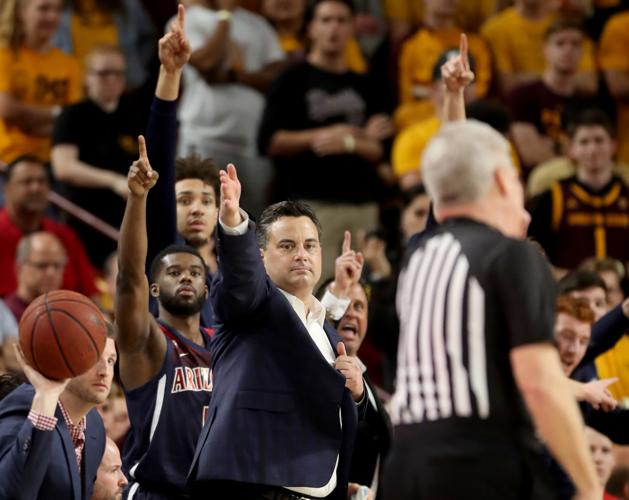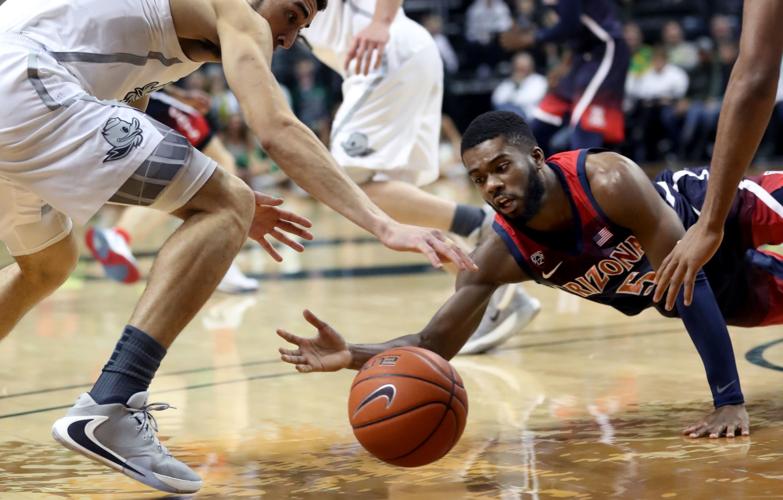Thanks to a newly fortified roster that can go up to 10 players deep without much drop-off in talent, Arizona coach Sean Miller built himself an extended-stay doghouse this season.
The occupancy level has been quite high recently, too.
Dylan Smith and Ira Lee were the first to crawl inside, back on Dec. 21 against St. John’s, Smith for his four turnovers in the first half and Lee for reasons Miller declined to specify at the time. Neither played in the second half while Miller turned elsewhere for help, and Arizona lost 70-67.
Then it was Chase Jeter’s turn. The UA’s then-starting center had only one rebound and went 0 for 3 from the field over the first 23 minutes at Oregon before Miller pulled him for the rest of Arizona’s 74-73 overtime loss.
Three days later, Jeter played only 17 minutes at Oregon State, where he collected just one rebound and, after Miller said he reported back pain on Jan. 14, has not played since. (Miller said Tuesday that the UA is still monitoring Jeter, who has been medically cleared, and that “we’ll see if we’re able to use him this week.”)
Meanwhile, Ira Lee sat out the first 16 minutes of Arizona’s 82-65 loss at OSU, at least in part because Miller said he was concerned about a matchup issue against OSU star Tres Tinkle.
Then on Saturday, sharpshooting guard Max Hazzard sat out the entire second half of the UA’s 66-65 loss at ASU after Miller said he botched several plays before halftime.
To Miller, these were all justifiable decisions.
“It’s no different than a teacher in the classroom,” Miller said. “There’s certain rules that you have to have in place for the classroom to be able to learn and for every student to have a chance to grow.
“If you want to go to the restroom, you have to use a hall pass. If you have a question, you need to raise your hand and you can’t talk when the teacher is talking. There’s certain protocol. In basketball it’s the same thing.”
Although he also blamed himself for not coaching better at ASU, saying he needs to put the Wildcats in a better position to be successful and provide them more confidence, Miller used the schoolroom analogy to discuss why he pulled Hazzard.
Miller said the grad transfer guard had not one but “four or five” tough plays in the first half, including a notable one on the UA’s final possession before halftime. That’s when Hazzard drove inside too early for a layup that missed, allowing ASU to score in the final nine seconds, cutting what was a 22-point UA lead to just 13 at halftime.
“If we didn’t get a shot up and the buzzer sounded, you’re still winning by 15. And if you shoot a 3, you could be up by 18,” Miller said. “If you get a two, or you get fouled, you can be up 16-17 points. But he drove in, took a bad shot, and we go from having a lead of 19 or 20 to getting outscored 6-0 in the last minute and a half.”
The fact that Hazzard is a fifth-year senior, one who heroically helped UC Irvine win its first-ever NCAA Tournament game last season, appeared to add to Miller’s disappointment.
“There’s a number of guys in the Arizona State game that didn’t play well. You know, I didn’t coach well,” Miller said. “We’re not asking for perfection, but you can’t, in a three-minute window, give up a three-point play, ball taken (by ASU for a) full-court drive, ignore the coach, give up a layup.
“One of the things that somebody like Max brings to our team is experience. He’s won 30 games, he’s won a conference championship. He’s played three or four years. He’s a great student. He’s a really, really great kid. He also shot a shot that could have been the worst shot that I’ve ever seen taken in a Pac-12 game. And it wasn’t as if he was hot, going 4 for 4. … to take a shot like that on the road when your team’s playing well, and from the right wing a running one hander? That’s not going to work. Not playing for me.”
After all that, Miller said, “I didn’t think it was in our best interest to play him at all in the second half.”
So he didn’t. But … what if Hazzard would have reset his focus after a halftime talk and hit a 3-pointer or two in a second half when the Wildcats were 0 for 8 from 3?
What if Lee would have pulled down two or three rebounds early at Oregon State and infused the Wildcats with his signature energy during a game when it was clearly lacking?
What if Jeter would have been a secondary post option when Zeke Nnaji wasn’t able to take a single shot in overtime at Oregon?
And what if Smith would’ve calmed down and hit a 3-pointer to beat St. John’s during a second half when the UA was 2 for 8 from beyond the arc?
It’s all theoretical, of course, and Miller wasn’t interested in going there. When asked if it gets frustrating to send a message when it might hurt the Wildcats at the same time, Miller shrugged.
“That’s the way it goes,” Miller said.
Miller added that he didn’t think benching Hazzard was that big a deal anyway.
“Happens all the time,” he said.
So it went. Guard Jemarl Baker said of Hazzard’s benching that with “things like that you have to move forward and continue to work.”
When Miller was asked how Hazzard has responded since then, he answered in a manner-of-fact tone.
“He put his stuff on, walked out there, participated in film, did every drill, practiced hard,” Miller said, “and we’re moving on.”





